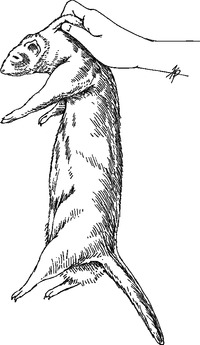CHAPTER 55. Ferrets
Patricia A. Schenck
RESTRAINT
I. Often only minimal restraint is needed
II. Restrain by placing a hand under the chest and lifting slightly
III. Scruffing can be used for restraint when the ferret is grasped by the skin on the back of the neck and lifted up (Figure 55-1)
 |
| Figure 55-1 “Scruffing” a ferret for restraint. (From Birchard SJ, Sherding RG. Saunders Manual of Small Animal Practice, 3rd ed. St Louis, 2006, Saunders.) |
IV. Ferrets can be restrained on a table by placing one hand over the back of the head and the other hand over the pelvis. Do not pull the legs back
DIAGNOSTIC AND THERAPEUTIC TECHNIQUES
I. Blood collection
A. Sites for blood collection include the cephalic vein, lateral saphenous vein, jugular vein, cranial vena cava, and ventral tail artery
B. Collect three times the amount of blood as the volume of serum or plasma required
C. Use 28-gauge or 25-gauge needles for peripheral veins. Use 25-gauge or 22-gauge needles for jugular vein or cranial vena cava collection
D. Blood collection from the ventral tail artery can be painful
II. Diagnostic imaging
A. Standard radiographic techniques are used
B. Sedation may be necessary
C. Splenomegaly is common
III. Bone marrow aspiration
A. Collect from the proximal femur or humerus
B. Use sedation
IV. Splenic aspiration
A. Do not perform if hemangiosarcoma is suspected
B. Sedation is not usually necessary
V. Cystocentesis
A. Use a 22-gauge or 25-gauge needle
B. Sedation or anesthesia may be necessary
VI. Intravenous (IV) therapy
A. Use the cephalic, lateral saphenous, or jugular veins for indwelling catheters
B. A 25-gauge butterfly catheter can be used in the cephalic vein for one-time administration
VII. Injections
A. Give subcutaneous (SC) injections over the shoulders
B. Give intramuscular (IM) injections in the quadriceps, semimembranosus, semitendinosus, or epaxial muscles of the back
VIII. Fluid therapy
A. Daily fluid requirement is approximately 70 to 100 mL/kg/day
B. Give SC fluids over the shoulders
C. Hypoglycemia is common; thus dextrose may be added to IV fluids
IX. Oral therapy. Liquid medications are the easiest to administer
X. Nutritional support
A. Can be force-fed using a syringe
B. Feed meat baby foods, slurried canned cat foods, or ferret food
XI. Drug-dosing guidelines
A. No drugs are approved for ferrets
B. Use feline dosages for most drugs
C. Use ivermectin for heartworm prevention
D. Enalapril may cause lethargy in ferrets
XII. Sedation and anesthesia
A. Use acepromazine for sedation. A combination of acepromazine and ketamine can be used for minor procedures
B. Do not use xylazine
C. Telazol can also be used as a sedative
D. Isoflurane by facemask is commonly used for induction
2. Analgesics used include buprenorphene, butorphanol, carprofen, and flunixin
INFECTIOUS DISEASES
I. Viral diseases
A. Canine distemper
1. Paramyxovirus; transmission is via direct contact or fomites
2. Clinical signs include conjunctivitis, fever, anorexia, mucopurulent oculonasal discharge, and central nervous system abnormalities
3. Fatal; there is no treatment
4. Vaccination is protective; vaccinate yearly
5. Do not use canine multivaccines that contain parvovirus, adenovirus
B. Influenza
1. Orthomyxovirus; transmission to and from humans
2. Clinical signs include conjunctivitis, nonproductive cough, diarrhea, anorexia, and fever
3. Treat supportively
C. Rabies
1. Rhabdovirus; transmission is via direct contact with infected saliva
2. No treatment
3. Some states allow a 10-day quarantine of an unvaccinated ferret involved in a bite incident; some states require euthanasia
4. Vaccinate with killed vaccine yearly
D. Aleutian disease
1. Parvovirus that also affects mink; transmission is via direct contact or fomites
2. Clinical signs include ataxia, lack of coordination, posterior paresis, tremors, wasting, anorexia, lethargy, melena, and urinary incontinence
3. Incubation period from 1 to 200 days
4. Serum protein electrophoresis shows hypergammaglobulinemia
5. An enzyme-linked immunosorbent assay (ELISA) test is available
6. There is no specific treatment; provide supportive care and isolate
II. Bacterial diseases
A. Common bacterial infections
1. Staphylococcus, Streptococcus, Escherichia coli, and others can cause bacterial infection
2. Abscesses are uncommon
3. Treat according to bacterial sensitivity
B. Botulism is rare but is caused by Clostridium botulinum toxin in uncooked food
C. Tuberculosis
1. Ferrets are susceptible to bovine, avian, and human tuberculosis
2. Transmitted by ingesting contaminated meat or milk
3. Clinical signs include weight loss and diarrhea
4. Because tuberculosis is zoonotic, animals should be euthanized and not treated
III. Fungal infections
A. Systemic fungal infections are rare
B. Blastomycosis, histoplasmosis, cryptococcosis, coccidioidomycosis, and aspergillosis have been reported
Stay updated, free articles. Join our Telegram channel

Full access? Get Clinical Tree


